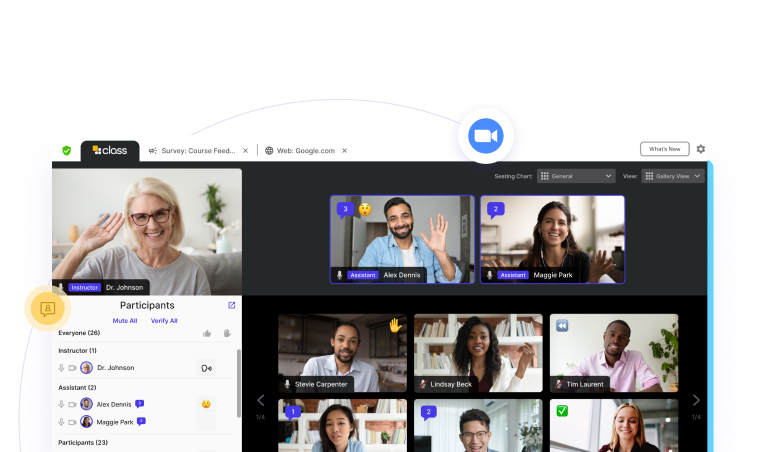
Matt is a passionate EdTech leader with 16 years of experience driving innovation in higher education. His commitment to enhancing student success and engagement, both on campus and online, is inspiring. Known for his contagious enthusiasm, Matt connects strategy with impactful outcomes.

Matt is a passionate EdTech leader with 16 years of experience driving innovation in higher education. His commitment to enhancing student success and engagement, both on campus and online, is inspiring. Known for his contagious enthusiasm, Matt connects strategy with impactful outcomes.

There’s a perception in higher education that online learning isn’t as effective as in-person education. But when you consider the unique opportunities virtual learning can bring, rethinking it can be an advantage, not a substitute or second-choice option. Instructors are seeing this value clearly, as a Harvard University task force found that 82% of their faculty were interested in adding digital tools they adopted while teaching remotely to their in-person classes. With the right infrastructure in place, you can pair technology with trusted instructional models, creating a virtual environment that offers advantages physical classrooms can’t.
Forward-thinking leaders in higher education will use these tools to offer personalized learning paths to flexible, global access to education. In this quick guide, you can explore the biggest benefits these programs offer, how they can help transform your approach to learning, and ways to use them to make your institution the preferred choice among students.
A compelling advantage of virtual learning is that it can break down geographic and scheduling barriers, offering access to quality education regardless of one’s location. Virtual learning expands access to world-class faculty, guest lecturers, and opportunities for global collaboration, and the flexibility of these models accommodates diverse time zones and learning styles.
This flexibility can also better support non-traditional students, working professionals, and lifelong learners, who may have demanding schedules or commitments that prevent them from attending in-person classes.
In traditional classrooms, student engagement and comprehension are often assessed subjectively. This method is less than desirable and prone to error. Purpose-built online learning platforms bring objectivity to this assessment process by using data and automation to:
By adapting the learning experience to each student’s needs in real time, virtual environments make it possible to nurture deeper understanding and academic growth, even in large, diverse groups of students.
Virtual learning environments are powerful tools, and they can expand active learning opportunities in ways that traditional classrooms can’t match. Interactive features like live polls, real-time automations, and AI-assisted discussions create dynamic spaces for student participation.
Virtual learning platforms also offer a wealth of interactive tools, like real-time simulations, interactive case studies, and digital labs to make learning more engaging and experiential. These platforms provide students with hands-on experience in a controlled, virtual environment, allowing instructors to bring abstract concepts to life in a more tangible way. Augmented and virtual reality also offer big benefits, enabling the creation of immersive learning experiences that surpass physical classroom limitations. Consider virtual platforms like Class, which support these capabilities through third-party tools and applications.
Virtual learning enables an easier way for instructors to connect with students, offering continuous, personalized support no matter where they are. This flexible and expanded availability helps students feel more supported and engaged, even when formal classes aren’t taking place.
Services like academic advising, career coaching, and mental health support can be integrated directly into a virtual classroom platform. By bringing these resources into the learning environment, colleges and universities will be able to offer students holistic care that addresses their academic and personal well-being.
In these digital-first communities, students can build relationships with peers and faculty members across disciplines through activities like networking events and collaborative research opportunities.
To make online learning a success, institutions must move beyond basic web conferencing tools and look to virtual learning environments that offer much more than a live classroom environment. Make sure to integrate learning management systems, student success platforms, and engagement analytics to create a complete digital experience.
Remember to include data-driven decision-making as a core component of your online program. This approach is essential to improving student retention and academic performance. By using the data provided by these integrated systems, institutions can identify trends and patterns that enable instructors to make quick adjustments to classes and increase their effectiveness.
Institutions that embrace digital-first strategies will be able to both meet the evolving demands of today’s learners and stand out in a competitive market. Enrollment trends support an online course strategy, with online universities seeing an 11% increase in enrollment, and traditional course enrollment dropping by an average of 3%.
Blending the best of virtual and physical learning allows instructors to offer flexible, personalized experiences that attract and retain a diverse student population. The future of higher education lies in creating dynamic, hybrid models that integrate the best of both virtual and physical learning for a richer, more impactful education.
Curious about how a purpose-built virtual learning environment can elevate your institution? Connect with a Class expert today.

Matt is a passionate EdTech leader with 16 years of experience driving innovation in higher education. His commitment to enhancing student success and engagement, both on campus and online, is inspiring. Known for his contagious enthusiasm, Matt connects strategy with impactful outcomes.

Matt is a passionate EdTech leader with 16 years of experience driving innovation in higher education. His commitment to enhancing student success and engagement, both on campus and online, is inspiring. Known for his contagious enthusiasm, Matt connects strategy with impactful outcomes.
Get our insights, tips, and best practices delivered to your inbox

Sign up for a product demo today to learn how Class’s virtual classroom powers digital transformation at your organization.

Features
Products
Integrations